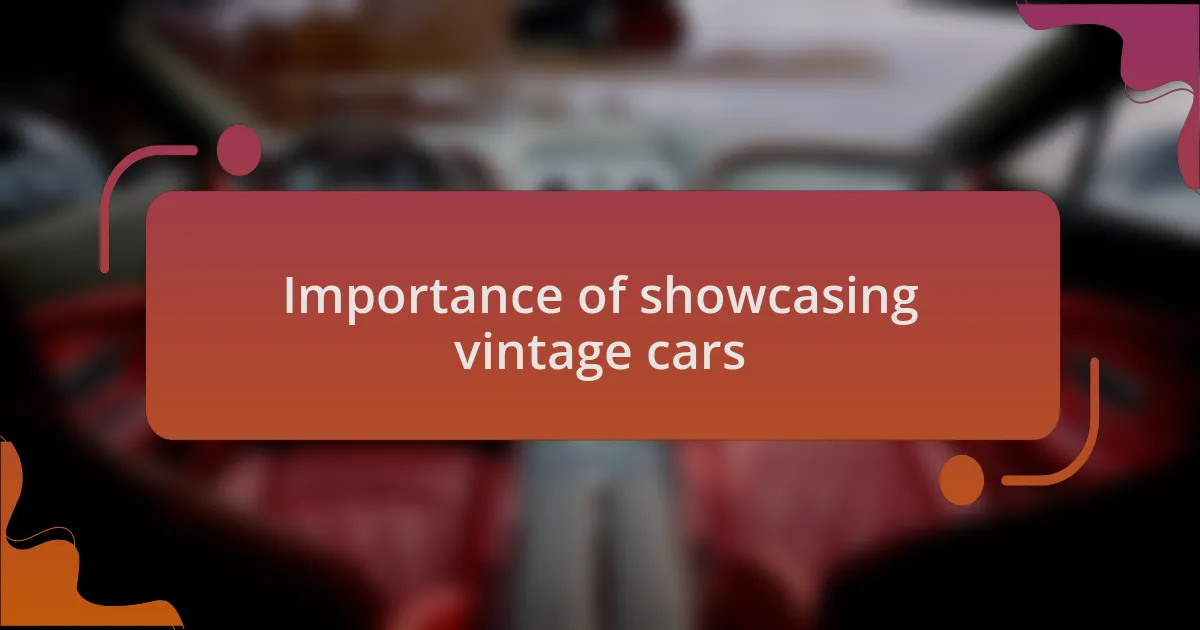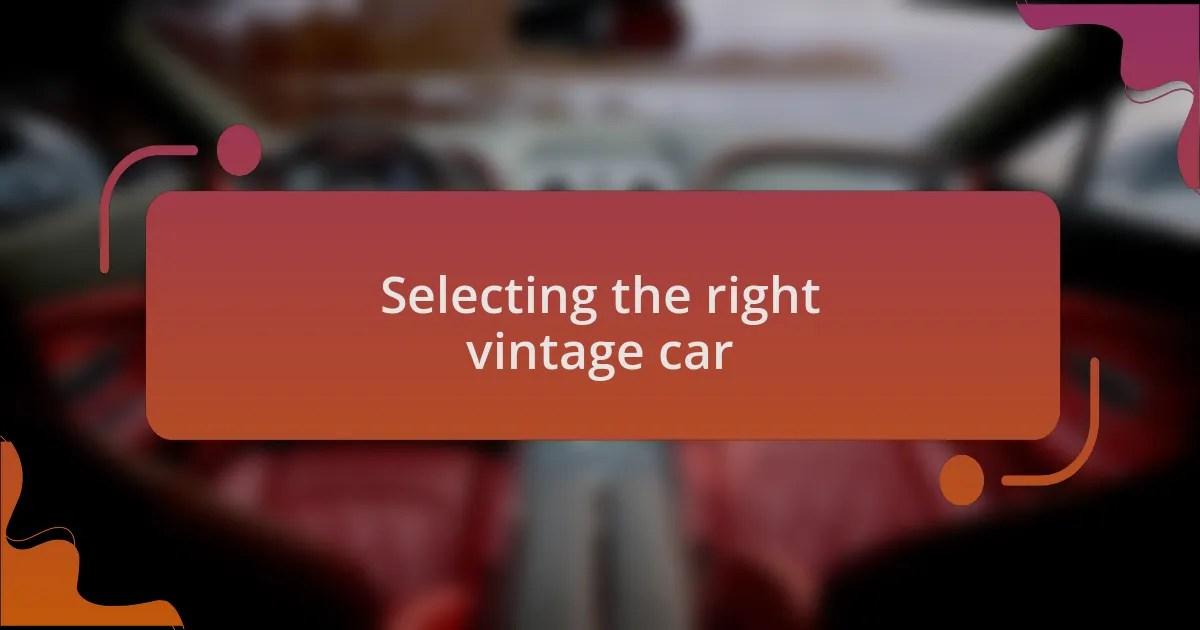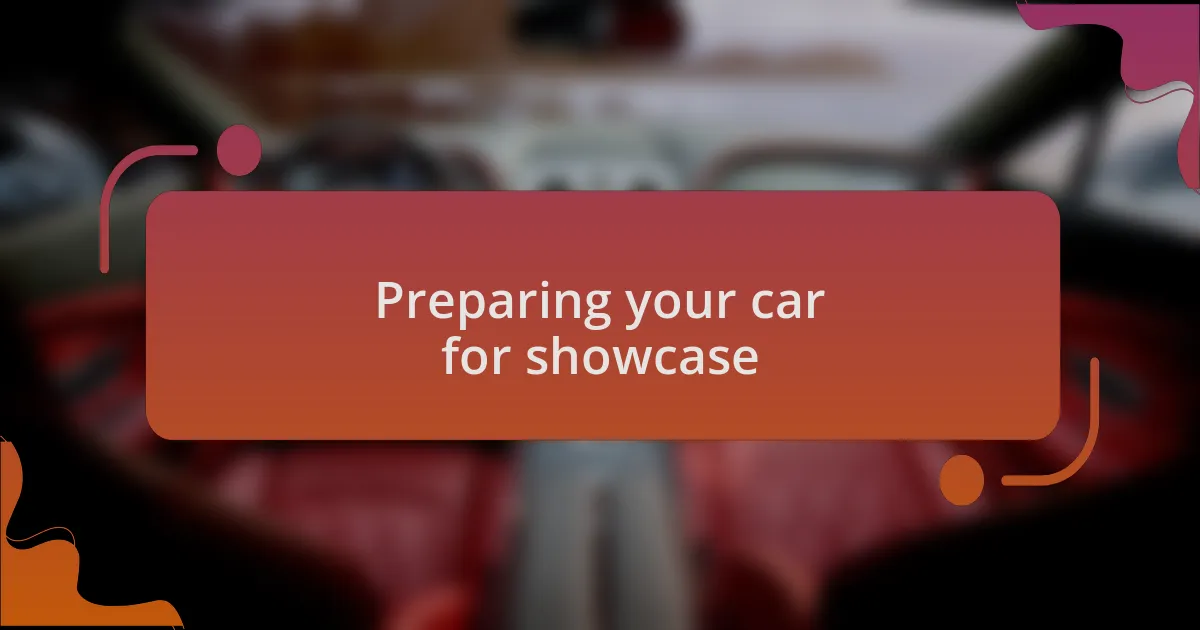Key takeaways:
- Showcasing vintage cars celebrates history and craftsmanship, fostering community connections among enthusiasts.
- Preparing for a car showcase requires organization, attention to detail, and building connections with fellow car lovers.
- Researching vintage car trends helps understand audience preferences and enhances the storytelling aspect of the showcase.
- Selecting the right vintage car balances emotional connections with practical considerations for a compelling presentation.

Importance of showcasing vintage cars
Showcasing vintage cars is about more than just displaying beautiful machinery; it’s a celebration of history and craftsmanship. I vividly remember standing beside a beautifully restored 1965 Mustang at my first car showcase, feeling the palpable excitement among fellow enthusiasts. Have you ever felt that rush of nostalgia when seeing an old car in pristine condition? It’s a connection that transcends generations.
The importance of these showcases lies in their ability to bring together a community that shares a passion for the artistry of vintage automobiles. Each car tells a story, and as I listened to owners passionately recount their restoration journeys, I realized how these events can spark friendships and foster lasting connections. How often do we get the chance to bond over shared interests these days?
Moreover, showcasing vintage cars plays a crucial role in preserving automotive history. It reminds us of the innovation and creativity that defined different eras. I recall admiring a classic Cadillac, its design reflective of a time when style and luxury were paramount. Being part of these events not only fuels my passion but also instills a sense of responsibility to keep that history alive for future generations.

Key steps to prepare
Preparing for my first car showcase was no small task, but I learned that starting with a checklist made all the difference. I recall sitting in my garage, pencil in hand, jotting down everything from polishing techniques to transportation logistics. Have you ever felt overwhelmed by details? Breaking it all down into manageable steps helped me focus and stay organized.
Once I had my checklist, I dug into the nitty-gritty of detailing my vintage car. I spent hours meticulously cleaning every nook and cranny, and that attention to detail truly paid off. I remember how gratifying it was to see my car shine under the showroom lights, and it sparked a renewed sense of pride in my work. The experience reminded me that each scuff and scratch tells a story, but making it presentable speaks volumes about my dedication.
Finally, I made it a point to connect with fellow car enthusiasts ahead of the event. I reached out through social media and forums, building excitement and camaraderie before the showcase. When I finally arrived, I was greeted like an old friend, reinforcing the idea that preparing for a car showcase goes beyond just the car itself—it’s also about forming connections and sharing our passion. How can we not connect over something we love so deeply?

Researching vintage car trends
Researching vintage car trends became an essential part of my preparation process. I found joy in browsing online forums and watching vintage car showcases on YouTube, observing what captured the audience’s attention. Have you ever noticed how certain models consistently steal the spotlight? It became clear to me that understanding these trends was not just about market value; it was about recognizing the stories behind each vehicle.
As I delved deeper, I joined local vintage car clubs, and I must say, the conversations ignited my passion further. Listening to veterans share their experiences and preferences revealed a treasure trove of information about what features were in vogue and what collectors were seeking. It was fascinating to discover that colors and modifications can sway a judge’s opinion significantly. Wouldn’t it be interesting to see how your car fits into these trends?
Eventually, I realized that keeping an eye on the latest shows and auctions also informed my approach. Witnessing the excitement surrounding specific models at these events helped me strategize how to present my car. Each car has its unique charm, and realizing that trends could amplify its story reinforced my desire to showcase it effectively. After all, isn’t it rewarding to tell a story that resonates with others?

Selecting the right vintage car
When it came to selecting the right vintage car for my showcase, I felt a certain thrill. I knew I needed to choose a model that not only resonated with me but also had the potential to captivate an audience. There’s something magical about a car that tells a story, and I often found myself imagining how a particular model would be received, envisioning its graceful lines and distinctive features sparking conversation among onlookers.
As I sifted through options, my heart raced when I stumbled upon a classic Mustang that had been lovingly restored. It wasn’t just any car; it was the same model my uncle used to drive when I was a kid. Remembering the wind in my hair as we cruised down quiet back roads together summoned a wave of nostalgia. But beyond sentiment, I understood that I had to consider its condition, originality, and demand. Would the fact that it held family memories enhance its appeal or distract from the technical aspects that judges often scrutinize?
Ultimately, selecting the right vintage car involved balancing emotional connections with practical considerations. It reminded me of piecing together a puzzle; every choice, from color to condition, affects the whole picture. As I look back, I realize that my decision was not just about picking a vehicle but curating a piece of history that I could proudly share with others. What stories would you want your car to tell?

Preparing your car for showcase
Preparing your vintage car for a showcase is as much an art as it is a science. I remember meticulously cleaning every inch of my Mustang; the gleam of the polished chrome brought a smile to my face. It’s funny how a little elbow grease can transform not just the car’s appearance, but also how you feel about it. As I prepped, I kept asking myself, “What do I want the audience to notice first?”
Beyond cleaning, I invested time in detailing. I spent hours ensuring the engine was as pristine as the exterior. It’s often easy to overlook the mechanical aspects, but I believe they speak volumes about the car’s history and care. Familiarizing myself with the specifics of my Mustang—its unique features and quirks—helped me share the narrative behind it when I interacted with fellow enthusiasts.
Finally, I focused on the aesthetics of my showcase display. I wanted the background to complement the car without overshadowing it. Choosing the right signage and props gave depth to my presentation, enhancing the overall experience for visitors. I found that the little touches, much like the subtle curves of a vintage car, can make all the difference. How would you convey your car’s personality to your audience?